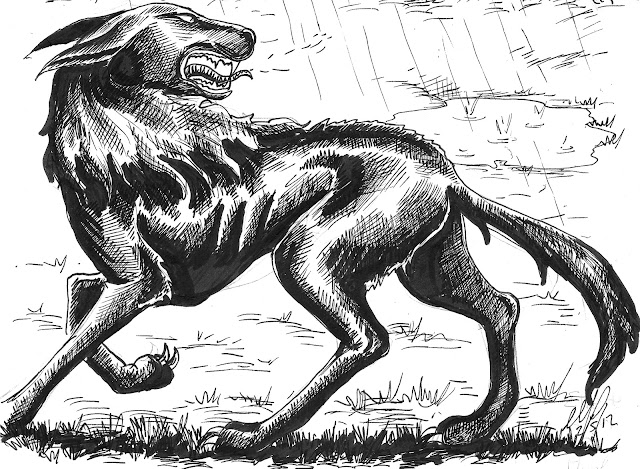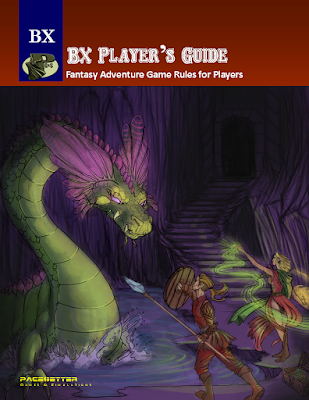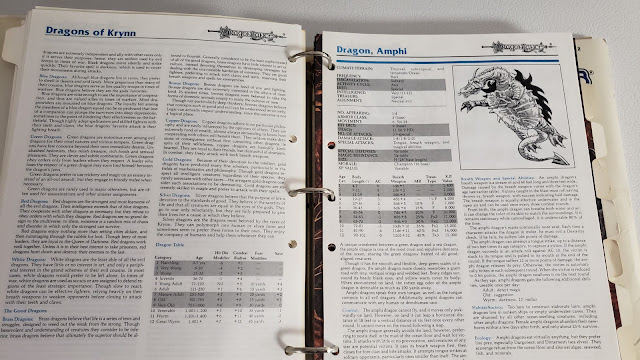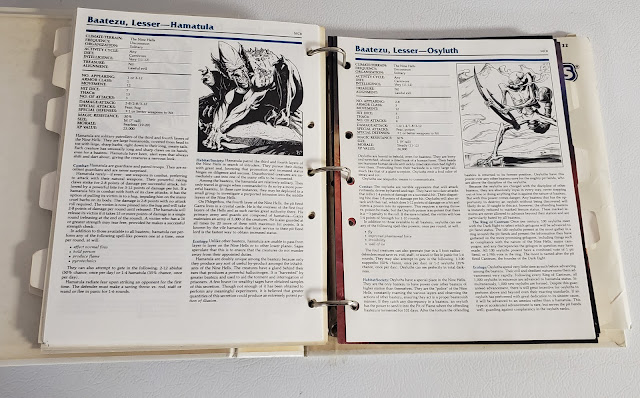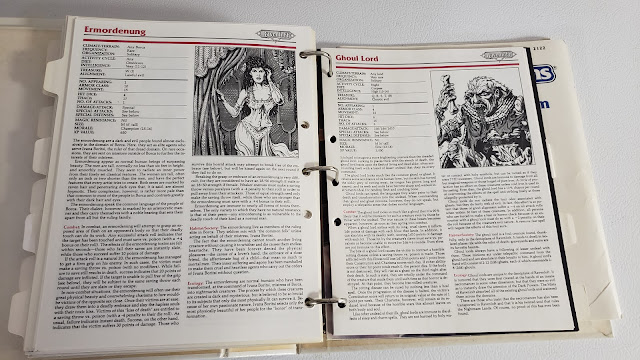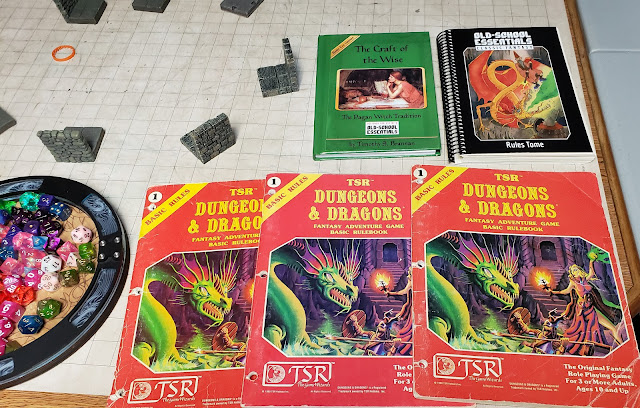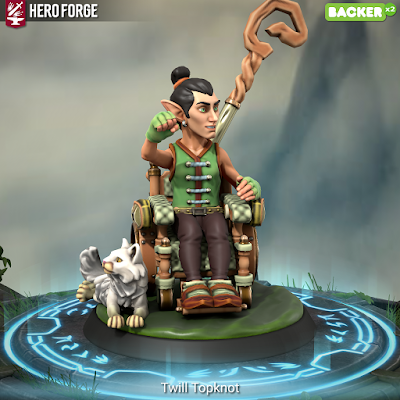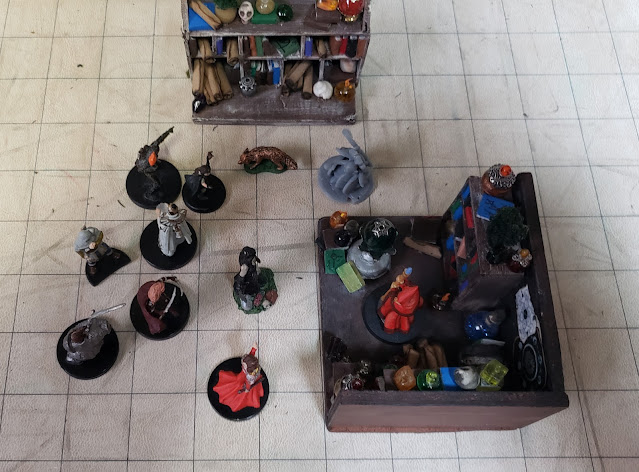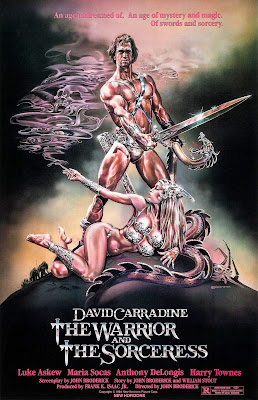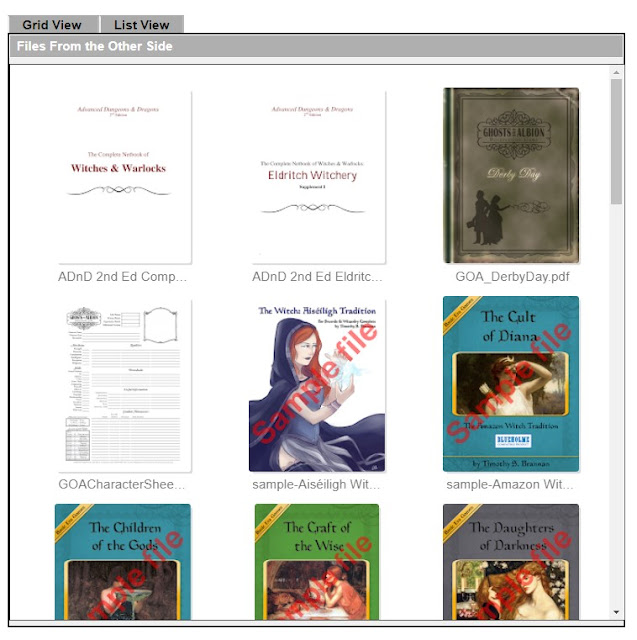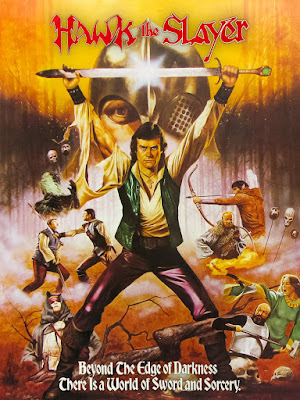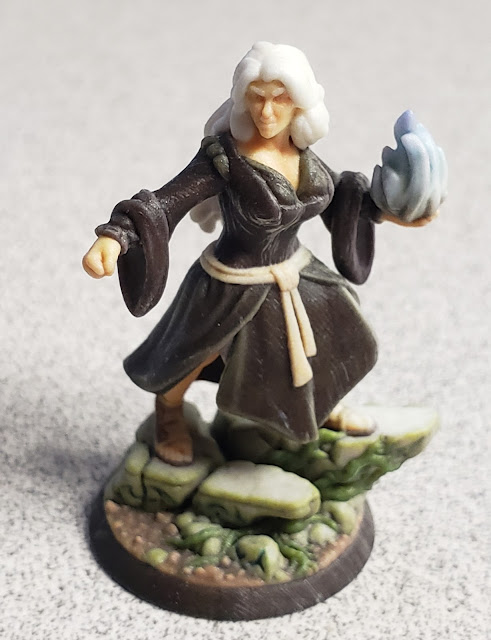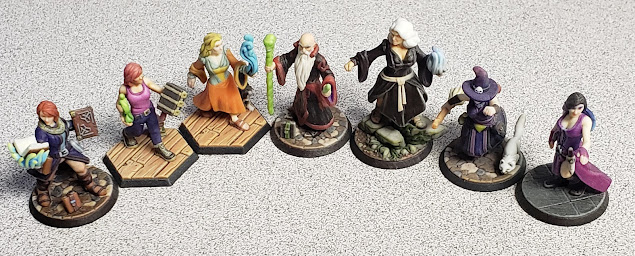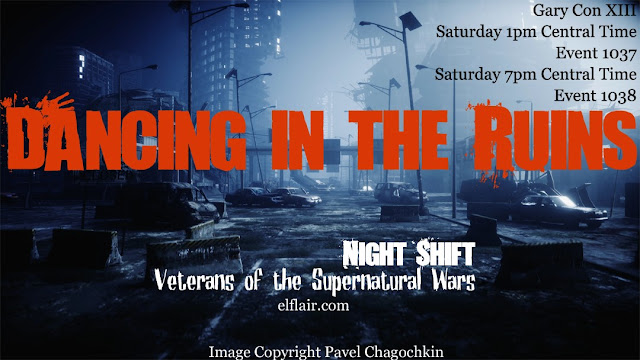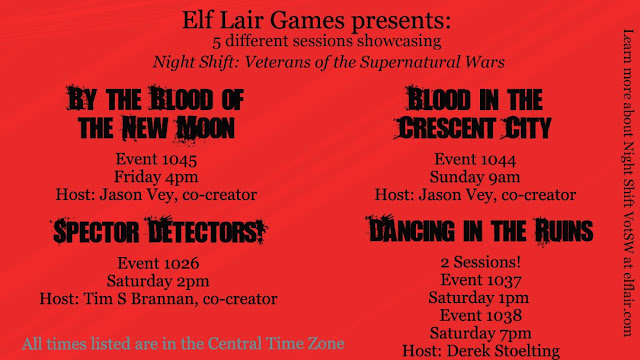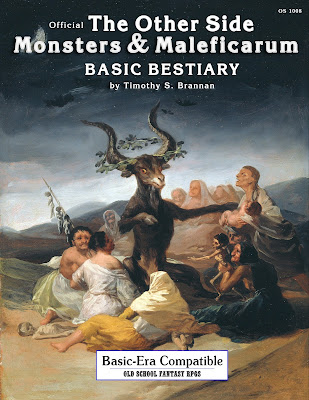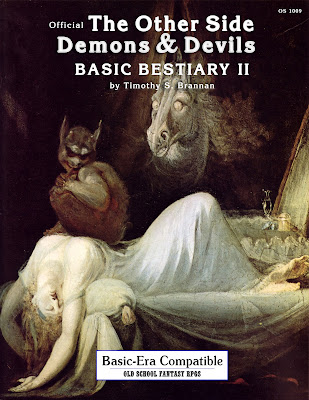It is a Monstrous Monday, but since I am going to be spending all of April dedicated to monsters I wanted to take this one to discuss something I am working on and working out for April. That is what form should my stat block take?

If you have followed my Monstrous Mondays over the years you may have seen the evolution of my monster stat blocks. There have been variances depending on which system I am favoring at that time, but I had not settled on one until the last year or so. After working with it for a while I am now looking to make some minor tweaks to it.
But before I do that I want to do some baselines and see what has been used in the past and by other OSR designers. Keep in mind that each stat block represented below was designed with that system in mind, I am not making any claims for cross-system use in these blocks, but I do hope to find something like that for my own.
Since I am going to be comparing several versions of the D&D game and various clones, I am going to need to pick a monster that is present in each one.
I can think of no better creature than the humble orc.
Actually, I have other reasons for that as well. Among the reasons, they are the archetypical D&D/Fantasy monster. Goblins would have worked too.
Hang on, this is going to be a long one.
Basic Stat Blocks
Let's look at the various stat blocks among what I call Basic Era Compatible games. I am not going to put up images of the entire entry.
Original Edition

Like much of OD&D it is simple enough IF you know where to go digging for all the data. But this one leaves some details to be desired. The emphasis on what sort of things orcs do in a wargame are nice.
Holmes Basic

Here we get to what can be considered the first of the true stat blocks. We can get the basic information we need at a glance. Movement, HD, AC, Treasure, Alignment, Attacks, and damage. There is more, but for now, let's consider this the absolute minimum.
Moldvay Basic B/X

Here the stat block expands to take on features from the new Basic game. Largely they are the same. A slight change in AC and Move is different. We now also have a No. Appearing category and Morale. Also, there is more description here. Moldvay is not assuming that readers already know what an orc is.
Mentzer Basic / BECMI

As expected this one is very much like Moldvay. We do have variance in Morale now based on leaders and Treasure Type is divided into individuals and hordes. The most useful though, and this is the influence from later in AD&D, we get a line for XP value. It's a straight number as opposed to a variable one based on hp (like in AD&D's later books).
Rules Cyclopedia/ RC

The Rules Cyclopedia follows the same evolution from Holmes as we see in Moldvay to Mentzer. For the number appearing, we get the actual dice mechanic, not the range, and there is an added line of Monster Type. Now all of these are largely compatible with the others and you can see how each one is describing the same creature. Also, all the blocks are very much the same.
Let's make things a little more Advanced.
Advanced Stat Blocks
Essentially this includes AD&D 1st Ed and AD&D 2nd, but I am going to include Editions 3 to 5 for completeness sake. I want to map some of the later editions' additions.
First Edition AD&D

Now here are few more changes. To get the right feel for the evolution here we need to go back to Holmes Basic. What is new? Well we get Frequency, Move is now map-based, Treasure Types lair and individuals, special attacks and defenses (even when they are nil), Magic Resistance (in a percentage), Intelligence (not a score, but a nominal rank), Size, and Psionic ability.
A few notes. Orcs switch over from Holmes Chaotic Evil to Lawful Evil. The art makes their pig-like features more prominent. These are largely the same creatures from Holmes and even other Basic games, but differences are beginning to creep in. Everything from the Basic stat block is here except for Morale (not used) and Save As (there is a chart).
Second Edition AD&D

OK. AD&D 2nd Ed was the king of robust monster write-ups. I loved the one full page per monster format even though I admit there was often a lot of fluff added. This stat block adds a lot more information. We are still talking about the same creature and the Holmes stat block is still visible here. Morale is back, though based on a d20 rather than d12/2d6. Still Lawful Evil. This block includes the Orog or half-orc/half-ogre creature. Do we know more about the orc than before? A little. A lot more in the descriptions.
While later AD&D 1 blocks included calculations, AD&D 2 made them standard from the start.
I want to take the next editions of D&D largely as a whole even though the compatibility between the newer editions (of the last 20 years) is less than the editions that came before them.
Post-2000 D&D: 3rd, 4th, and 5th Editions
Third Edition D&D

Third edition had a noble goal. Monsters should be built just like characters. It was good. Yes, it made creating high-level monsters more difficult but it all held together mechanically. 3e also introduced some new ideas in a stat block that I believe are worth looking into.
Things are grouped together well. Something that Pathfinder would later improve on. On our orc here we see a few things. AC is broken down into what is worn, what is natural, and what is due to dexterity. What is the orc's dex? Well that, and all their average abilities are listed here. Nice touch. Same with the saves. Alignment gets a shift. Not just that the orc here is back to Chaotic Evil (ala Holmes) but also there is the qualifier Often. Orcs by the way shifted to Chaotic because Barbarians can't be of Lawful alignment and that was their "Prefered" class. Though by looking at the level and advancement an orc can start out in any class and move up. So again this one harkens back to Holmes in terms of monsters as characters.
As we move through the editions the more verbose the stat block gets. In some ways this good and expected as the complexity of the game increased and more rules to cover more of the things DMs run into are needed. The downside is how much of that information is needed in combat? 3e added skills and feats, so we need to know those. Knowing the typical strength of an Orc is 17 is nice. But we are a long way from the seven lines in Holmes.
The biggest addition here though is the notion of CR or Challenge Rating. This gave DMs an idea of how tough the monster was when setting them against an average party. A CR 1/2 is easy for a party of 1st level characters. It was also how XP is calculated. A CR 1/2 orc is worth 150 xp by itself to a party of 1st level characters. But to a party of 8th level characters it is only worth 100xp. To 9th level characters it is worth 0 XP unless there are a lot of them. I liked this sliding scale and it made sense given the combat abilities of higher-level D&D 3 characters.
Fourth Edition D&D
Building monsters like characters is a great idea on paper, but in practice, we get some very, very complicated monsters at a high level. Quick. How many feats does an Adult Gold Dragon have? 4e attempted to fix that issue some.

Where previous editions (2nd is the best example here) gave us additional lines for different types of orcs or gave us the tools to advance them (3rd edition), 4th edition gave us different stat blocks that could get more detailed as needed.
Monsters are built less like characters, but still use some of the same principles. The stat blocks are tighter than 1st through 3rd, but you need a lot more of them. For example, in the 4e Monster Manual, there are seven orc stat blocks to cover the different sorts of orcs.
Like 2nd Ed, the stat blocks and monster descriptions are "modular." That is that the entry for most monsters are limited to one full page. In fact all of D&D 4 is like that. One could conceivably make D&D 4 so modular it is an à la carte D&D. I could assemble my own monster book with entries from the three monster manuals plus any adventure or other source book. As a game designer, it is appealing.
What is new here though? Well, 4e introduces the idea of "unaligned" alignment. It's like "True Neutral" but more of a "you do you and I'll do me and we will be fine" and less of "the balance must be preserved." There is also a line for languages known which is a good addition in my mind. Though I notice that orcs no longer speak "orc." Well. Actually, they do, "orc" is just a corrupt form of "Giant" here, which in turn is a debased form of Primordial.
Fifth Edition D&D

In its goal to be all things to everyone 5th edition tries to strike a balance. The stat blocks are robust enough to give you all the information you need, but significantly different versions of the monsters are separated off.
I can't help but think that D&D5 was looking over the shoulder of Pathfinder when organizing their blocks. Basic combat "Defense" is at the top. What do I need to hit and how often do I need to hit it? Size and type appear right under the name as they have since 3e and a little bit of the Rules Cyclopedia. We get their typical abilities. We get skill listings that are not just +0. Senses, Languages (oh look! "Orc" is back!) AND a combo CR and XP. While not listed above, 5e retains the "unaligned" alignment.
Hitpoints are more important than HD here. All their attacks and saves are already calculated and listed. They do follow the same rules as do characters, but not slavishly so like 3e. The war chief has a Gruumsh's Fury ability that you won't find in a character write-up. I mean yeah they are similar to barbarians, but not exactly.
Like 1st ed and 3rd ed these monster entries span pages. While this messes with my sense of design, it does mean that we don't 300 pages where 250 pages will suffice. The unneeded padding and white space is gone.
Judging solely by this it looks like Orcs are back to being a threat to 1st levels. The 4e orc could mow through first-level characters.
That is the evolution of the D&D monster stat block over the first 40 years of D&D. They say hindsight is 20/20 so what have the retro-clone designers done?
Retro Clones of the OSR
Here are a couple of stat blocks.

Starting with OSRIC it does exactly as we would expect. It lays material out much like AD&D 1st ed with the knowledge that Level/XP will be useful in the block. Orcs come out to an average of 15 XP this way; same as 1st and 2nd ed. Movement is now done in terms relative to the creature, not map movement. For various reasons, there is no treasure type listed. Treasure is spelled out in the description. This does give the DM more flexibility.

Labyrinth Lord comes very, close to OSRIC, but is more Basic in its presentation. The same information is given. LL gets past the Treasure Type and goes with Horde Class, but there are translations out there. Again when talking about hindsight; the XP value is included. Morale is back.
 Basic Fantasy
Basic Fantasy covers similar ground, but its 3rd Ed DNA shows through in AC. The block also leaves room for expansion as see here with N. Appearing.

I am posting more of the Old-School Essentials block to make a point here about design. Gavin Norman at Necrotic Gnome took the idea of modularity and really went with it. I can't say for certain he played D&D 4, but there are some ideas here that really call back to it. OSE gives us the most compact basic stat block so far. Like 5e all the defense and attack information is upfront. Brief description. Saves are detailed, morale is back and detailed. There are even XP values. The text of the monster is bullet-pointed. It is a model of efficiency really. We know nothing about languages or climate these creatures favor, but that is fine. It is mimicking the detail of the source game; Moldvay Basic.

Dark Dungeons, a Rules Cyclopedia clone, uses long columns for their monster entries, usually three to a page and filling a page. So similar modularity as 4e and OSE. In fact the stat blocks could be used with OSE with no issues. No surprise given the relationship of their spiritual ancestors; RC to Dark Dungeons and Moldvay Basic/Cook Expert to OSE. Morale is presented a bit differently, but average hp is included along with the XP values. Saves are listed out. There is a habitat now included along with Type.
Moving out to other games that don't specifically try to emulate any game in particular but the "D&D experience in general.

Adventurer, Conquerer, King System (ACKS) is largely based on Basic-era D&D and Moldvay Basic in particular, though it has some house rules. Move is back to Basic (as was LL and OSE). Percent in lair is lifted from AD&D style games. The text descriptions match the world ACKS works in. Notably these orcs seem to be a little harder to hit.

If ACKS is Basic moving towards Advanced, then Astonishing Swordsmen & Sorcerers of Hyperboria (AS&SH) is Advanced presented like Basic. Again we see similar entries. Saves are a single number (more on that in a bit), morale is present (like Basic) and XP (still 10) are listed. Like ACKS, the orcs of AS&SH fit their world a little differently than a generic D&D world. Here they are offspring of humans and dæmons. This also uses the 1st and 2nd ed (and really Basic) means of displaying variants; via a table. 3e leaves you to recalculate everything and 4e and 5e have separate sub-entries.
Moving out to even more different games.

Swords & Wizardry shares DNA with OSRIC but has become its own thing. While many will claim it emulates OD&D it is a really slimed-down version of AD&D to Basic-era levels. The stat block is more basic in its organization and content. Alignment is a simple three-axis (like Basic), the move is "map relative" like AD&D and Challenge Level is from AD&D. XP values are also AD&D derived.
The big thing that you should notice here is the advent of the single saving throw number. AS&SH does this too, but S&W did it first. It does simplify things to a large degree. It does have a very simple layout. The massive monster books for S&W; Monstrosities (544 pages) and Tomes of Horrors Complete (688 pages) are huge books. Both books expand the monster entries to fill a complete page in the same manner as 2nd Ed or 4th Ed.
There are a few more. Castles & Crusades and Adventures Dark & Deep are two more that also take our Orc to different places, but are still close enough to be familiar.
Looking at all of these, knowing that each is needed for their own specific game, I need to figure out what is necessary for my own stat block, or even what is needed for a good "universal" stat block. One that can be read and used for any "old school" version of *D&D or clone. I also want to learn from what has come after that as well.
What seems to be central are HD, hp, AC, attacks. Saves, XP, Treasure can all be derived. Alignment can be figured out. I am hoping to figure that all out during April. In the meantime, lets use my obsessive-compulsive nature to have some fun with monsters!
